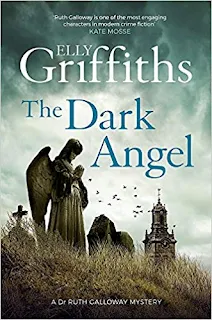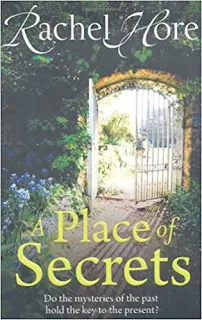I'm carrying on my blog review project for another month... though I've pretty much gone back to crime fiction and some favourite authors for this month. No domestic noir for me in April!
In case you're interested, here are the other posts so far from 2019:
January,
February,
March. But here are the books I read in April...
Beneath the Surface by Jo Spain (2016)
I discovered Jo Spain in December, when I bought a copy of her first novel (
With Our Blessing) in a charity shop. I enjoyed the book and passed it on to my mum. She enjoyed it so much, she immediately went out and bought two more of Spain’s novels. And now she’s passed those on to me.
Beneath the Surface is the second book in the detective series, so it features the same team of detectives as
With Our Blessing. D.I. Tom Reynolds is called to investigate a murder at Leinster House, the seat of the Irish parliament. Ryan Finnegan, a highly-regarded government official, has been shot – and the suspects are made up of the great and the good of Irish politics. I didn’t enjoy this one
quite as much as
With Our Blessing, but that says much more about my tastes than Spain’s writing. I loved the Gothic atmosphere of the snowed-in convent at Christmas in the first book, and the world of politicians, civil servants and lobbyists wasn’t quite as creepy and evocative. However, Spain’s writing is great, and
Beneath the Surface is definitely another page-turner. I also really liked the good balance Spain struck between political intrigue and murder mystery (even if I did spot the killer a little bit too early!). The detectives here are easy to like, and their personal lives don’t dominate too much. A warning though… there are
With Our Blessing spoilers in this one, so best to read the books in order.
Sleeping Beauties by Jo Spain (2017)
I decided just to go straight to Jo Spain’s next book – also lent by my mum.
Sleeping Beauties is another mystery for D.I. Tom Reynolds and his team, though at first it seems to be quite a different sort of crime novel to
Beneath the Surface. The book begins with the discovery of a woman’s body at the tourist spot of Glendalough. The body has been buried in a shallow grave, and the detectives quickly work out that it’s missing woman Una Dolan. But they also realize that there are four other grave sites in the same area – Reynolds’s team are faced with a serial killer. While
Sleeping Beauties does tread familiar ‘hunt for a serial killer’ ground – there’s some profiling, lots of working out the ‘type’ that the victims adhere to, some pretty grisly and unsettling details – it is still a mystery. As in her previous books, Spain is keen to follow the same rules of detective fiction that you might find in older mysteries (the killer is always someone who has appeared in the story before, for instance). There are also some neat clues – one in particular that I really liked (no spoilers!) – that make this a proper whodunit, rather than a procedural thriller. Again, Spain strikes a good balance between the case and the detectives’ private lives, though I must admit I found myself really rooting for one non-case-related storyline a bit more than I thought I would. A well-written and compelling read – definitely recommend this one.
The Chalk Pit by Elly Griffiths (2017)
I read one of Elly Griffiths’s Dr Ruth Galloway novels last month, after buying it from a charity book sale at the supermarket. This month, I discovered another book in the series on the same shelf so I thought I’d give it a go. It was kind of a weird experience. The previous book I’d read was the second in the series (
The Janus Stone), but
The Chalk Pit is the ninth – so I was picking up with characters nearly seven years after I’d last seen them. However, the basic set-up remains the same: Ruth Galloway is a forensic archaeologist who helps the Norfolk police out with their investigations. D.I. Harry Nelson is the lead cop for the series (and his relationship with Ruth is… complicated). In
The Chalk Pit, bones are discovered on an underground building site (which is also how
The Janus Stone kicked off, but that’s fair enough, since there’s very little other reason to bring in a forensic archaeologist) – certain markings on the bones lead Ruth to suspect something very sinister has been going on under the streets of Norfolk. When Nelson’s team are contacted about a missing homeless woman, the picture starts to look even creepier. This is an entertaining read, with some interesting bits about tunnels and catacombs (and some virtuous commentary on homelessness and rough sleeping). However, as with
The Janus Stone, the book tends to get a little bogged down in the ongoing (increasingly complicated) soap opera of the detectives’ private lives.
Transcription by Kate Atkinson (2018)
I’m a big fan of Kate Atkinson’s novels (though weirdly not, as I discovered last year, of her Jackson Brodie books).
Behind the Scenes at the Museum is one of my favourite books of all time, and I really loved
Life After Life and
A God in Ruins – now there’s a book with a twist. Like
Life After Life and
God in Ruins,
Transcription is partly set during WWII, though (as with the other two) there’s a good chunk that takes place after the war as well.
Transcription is a spy novel, and it follows the story of Juliet Armstrong, who is recruited into the Secret Service to help with an operation to root out Fascist sympathizers in Britain. As befits a spy novel, the task Juliet is given is sometimes murky and uncertain, and the chain of command isn’t always clear. The story moves between 1940, when Juliet is working for MI5, and 1950, when Juliet is working for the BBC; however, the war casts long shadows, and the 1950 storyline sees figures from the past coming back to confront Juliet.
Transcription is written in Atkinson’s characteristic style, so it’s full of things that are unsaid, unclear and confusing. Everything is connected, though, and the book builds towards an ending that is full of revelations. And yet, it’s also a spy novel, so that ending also leaves some questions unanswered. The historical details in
Transcription are really captivating, and Atkinson draws you into Juliet’s world with her usual brilliance.
The Shape of Snakes by Minette Walters (2000)
Don’t know where to start with this one – this book
devastated me (I literally stayed up all night to finish it, so I’m shattered too). I really enjoyed
The Sculptress, but haven’t actually read any other books by Walters. So I thought I’d give
The Shape of Snakes a go. The book begins in Richmond in 1978, with the death of a woman known as ‘Mad Annie’. Annie is the only black person on the street and has suffered a variety of torments at the hands of her white neighbours. As we learn early on, Annie also has Tourette’s (hence the ‘Mad’ soubriquet), and drinks to self-medicate. Annie’s death is recorded as an accident, but the narrator (known only as ‘M’ or ‘Mrs Ranelagh’) believes she was murdered. And she is not for letting that go, even when the neighbours turn on her. However, all of this happens before the story really begins – the bulk of the book takes place in 1999, when M returns from overseas ostensibly to investigate, but actually to resolve the unsettling situation. You may know that I’m fond of unreliable narrators – and M is just that. There is
so much to the story that the narrator is withholding from the reader in this one. It’s a deeply disturbing book (with violence, sexual assault, racism and animal cruelty – be warned), but so incredibly well-constructed and well-written that it completely blew me away. The last page reduced me to uncontrollable tears – that’s how you write an ending!
Surfeit of Lampreys by Ngaio Marsh (1941)
I recently had a bit of charity shop binge while we were staying in Bakewell (there’s a lot of charity shops in Bakewell).
The Shape of Snakes was one of the books I bought – the next one on the pile was
Surfeit of Lampreys, which is quite a different kettle of fish. I haven’t read a huge amount of Ngaio Marsh – I’ve never rated the Inspector Alleyn books quite as high as some other Golden Age detective fiction – but I’ve enjoyed the books I have read. And
Surfeit of Lampreys is certainly enjoyable. The book introduces the Lamprey family, a gaggle of charming eccentrics who coast from financial crisis to financial crisis without getting particularly ruffled about it. The early section of the book is mostly concerned with setting up the characters (the many Lampreys, and their friend Roberta Grey) and their idiosyncratic lifestyle. However, things take a darker turn when the Lampreys’ boring (but rich) Uncle Gabriel is murdered at their London flat. It’s up to Inspector Alleyn to work out whodunit.
Surfeit of Lampreys is a curious book: the fatuous, fashionable silliness of the Lamprey family is juxtaposed with a particular brutal and grisly murder, and the investigation takes place almost entirely at the scene of the crime. It’s a wonderful – and very entertaining – character study, with some light-hearted commentary on the finances of the landed gentry, but the puzzle at the heart of it isn’t quite as fiendish as it first appears. Nevertheless, I really enjoyed it.






















